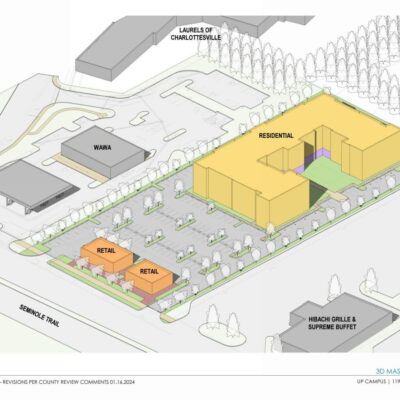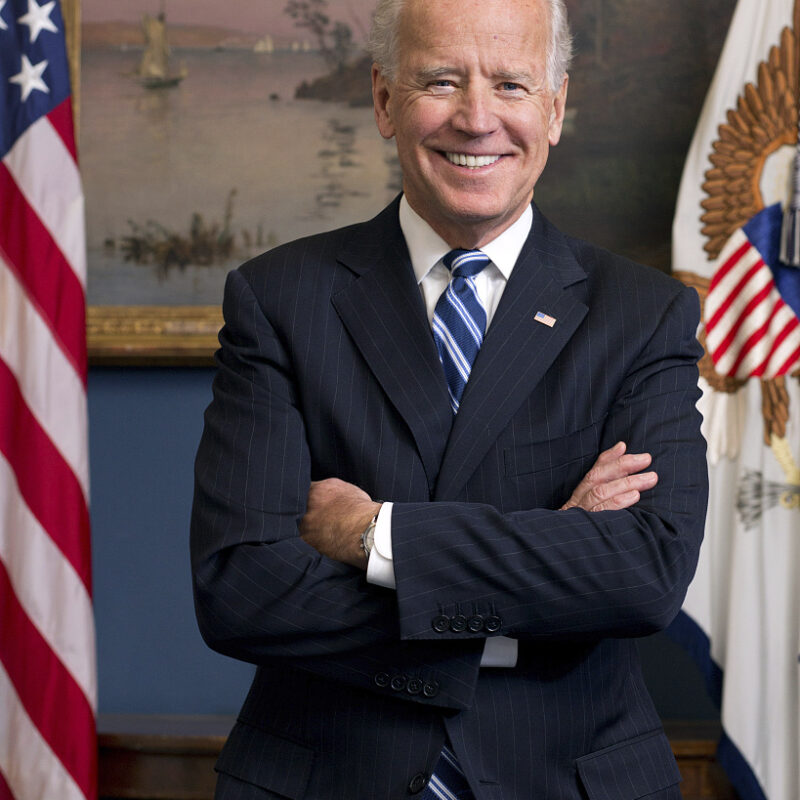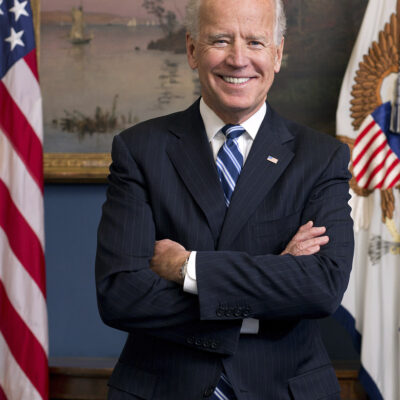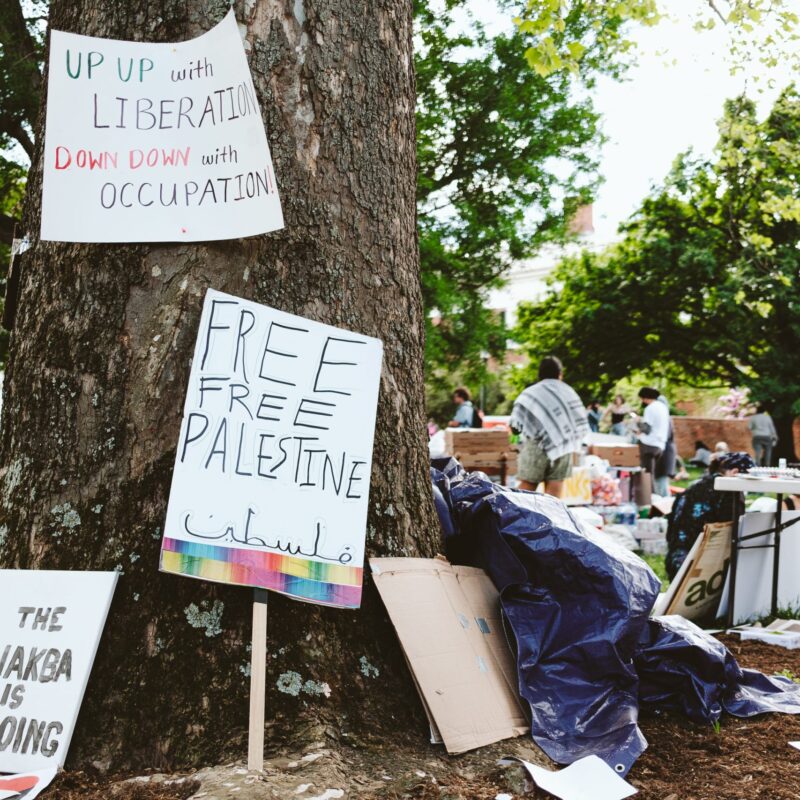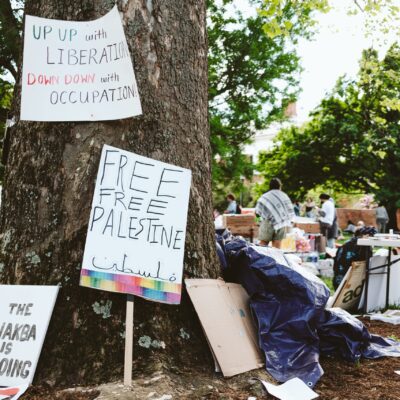Emily Traylor wasn’t ready to go directly to a four-year university. She wanted to ease into college life. “I don’t know if I could have handled UVA going straight out of high school,” she says. She weighed the options and then Traylor decided to give Piedmont Virginia Community College a try.
 |
A growing number of students are like Traylor, eyeing community college as an effective and viable source of higher education.
And that trend makes Frank Friedman very happy. The president of PVCC for the past 11 years, Friedman is a convincing pitchman for the two-year college option.
“The emphasis is not just teaching the elite, the academically successful, but giving everyone the opportunity to get an education, to advance their lives, to give people a second chance, or a third chance, or a tenth chance if they are ready to take that chance,” he says. “It’s a perfect match between my beliefs in social justice and my beliefs about society and working with those who maybe didn’t have the advantages that I had.”
But just as attractive tuition rates, the need for worker retooling, and other economic realities give rise to the demand for community college, funding is taking a significant hit. And that trend makes Friedman considerably less happy. According to the Pew Research Center, in October 2007, 3.1 million young adults between the ages of 18 to 24 were enrolled in community colleges. In October 2008, that number has risen to 3.4 million, or 10.8 percent. By contrast, enrollment at a four-year university remained the same between 2007 and 2008.
“It’s a very difficult situation when you have more and more students who need more and more classes and more services and yet, you have experienced three 5-percent budget cuts over the same period of time,” he says.
PVCC serves about 5,700 students with far fewer resources than many similarly sized state colleges. The annual operating budget is around $17.3 million. Longwood University in Farmville has 4,700 students—1,000 less than PVCC—and operates on about $90 million a year. William and Mary, for another example, has roughly the same number of students as PVCC, yet operates with a budget that is 14 times greater, about $260 million.
Moreover, Governor Tim Kaine cut state funding for the Virginia Community Colleges system by 13 percent over the summer. Using federal stimulus funds to offset a portion of that reduction, the resulting budget cut for PVCC was 6.9 percent, or $580,000. And that was on top of two additional rounds of budget cuts over a one year time period.
“Our goal, whenever we have these cuts, and we’ve had so many of them we’re getting good at this, I think, is always to minimize the impact on students, to minimize the impact on our core functions, teaching and learning,” says Friedman.
The little college that could
Friedman entered the community college world by chance. As a recent Ph.D. graduate from Purdue University looking for his first job, he took what he was offered.
|
“[President Friedman] is very, very friendly, just a personable individual,” says Emily Traylor. The editor-in-chief of PVCC’s the Forum says that she had the opportunity to interview him three times. “He was one of my favorite interviews, because he would give his answers so succinctly and clearly.” Those who work closely with him say Friedman, pictured here with students, loves being out in the halls greeting students, faculty and staff. |
“I knew what I wanted to do was to teach,” he says. “The only job I was offered was at a community college.” With a $12,000 annual salary, the Philadelphia native began his career in community colleges. That was 1977.
His belief in the mission of community college has not wavered in that time. “It’s who it educates that fits me perfectly,” he says—the emphasis on educating the masses.
On a crisp fall morning, the drive up College Drive to PVCC’s main building is a delight to the senses. Perfectly managed green lawns that surround the main campus building are dotted by sturdy evergreens. The tranquility is disrupted regularly, however, by the ongoing zoom of cars whose drivers circle for an elusive parking space and the buzzing and clanging of construction crews working on the Kluge-Moses Science Building, a clear sign of PVCC’s need for more classrooms and labs.
Perhaps as a reflection of his demeanor, Friedman’s office is modest (those who work closely with him say he doesn’t enjoy being in the spotlight). An oversized wood desk covered, neatly, by stacks of papers. Close to the windows, a glass table with four chairs.
The only indication of his stature as president is the view. From Friedman’s office, one can see rolling hills, ducks feasting on seeds and a small pond. Yet, Friedman doesn’t seem satisfied, focusing instead on the age of the 105,000-square-foot Main Building. The structure has the classic ‘70s boxy, sterile look, complete with long halls and slim windows. And on a hot August day when he meets with a reporter in his office, it’s clear that the air conditioning system needs updating, too.
And all these things cost money.
But Friedman doesn’t seem like the kind of guy who sits around feeling discouraged. He and the administrative staff have a plan in place to get through tough times.
First, “We will have a reduction in equipment purchases this year,” he says. Second, “We will have a reduction in the amount of money we spend on professional development for our faculty and staff this year.” Routine and preventive maintenance will also be reduced. Currently vacant positions won’t be filled. “We had planned an upgrade to our information technology infrastructure, and we’ll have to delay that,” he says.
“None of that is good news,” says Friedman. “But the good news is that we’re able to handle this round of cuts, as you can see, with no reductions in force of our current faculty and staff.”
|
PVCC IN A NUTSHELL Year established: 1972 Address: 501 College Drive, Charlottesville, Virginia 22902 Website: www.pvcc.edu Accreditation: Commission on Colleges of the Southern Association of Colleges and Schools Size: Main Building–105,000 square feet; V. Earl Dickinson Building for Humanities and Social Sciences–36,500 square feet. Tuition: for 2009, Virginia residents paid $95.35 per credit hour. Out-of-state residents paid $277.45 per credit hour. Average Semester Tuition for 2008-2009: $2,584. Faculty: 64 full-time; as many as 200 adjunct faculty are hired each year. Number of degrees offered: more than 35 Degrees conferred since 1972: more than 9,000 Students enrolled since 1972: more than 102,000 Awards and Recognition: February 2008, February 2009 |
And that’s Friedman’s strength: keeping a positive attitude, hardship notwithstanding. Time and again, he goes back to PVCC’s mission.
“He is very focused on responding to any unmet community needs,” says Glenn DuBois, chancellor of Virginia’s Community Colleges. “He is also a strong leader. He doesn’t hide in the shadows.”
College and university presidents are usually controversial figures. Their decisions, visions and attitudes shape the legacy of their institutions. But if there are disgruntled people out there who are offended by Friedman’s leadership, then they must be in hiding.
Friedman says he never dwells in negativity. Not that he lacks a critical edge. On a scale of 1 to 10, he says, he rates PVCC’s success as a solid 9. “The reason I don’t give us a 10 is because I don’t care what college you are, or what business you are, or what enterprise you are, but there is always room to improve,” he says. In a buttoned-down shirt and neatly ironed dress pants, he sits comfortably in one of the chairs around the glass table, and reiterates his vision.
“To me, the definition of ‘better’ is for our students to achieve a greater and greater level of success.”
Success is often the result of strong leadership, says Robert Templin, Jr., who heads Northern Virginia Community College (NOVA). In the last year, NOVA, one of the largest community colleges in the state with six campuses edging Washington D.C., has served more than 67,000 students in credit courses. Just like PVCC, over the last three years, NOVA’s student population increased by 23 percent.
Templin is no stranger to PVCC. At one time on the faculty at the UVA Curry School, he became the Dean of Instruction at PVCC and from 1978 to 1984 served as chief academic officer.
“There are some distinctive elements to Piedmont Virginia Community College,” he says. Aside from the long and close working relationship with UVA that facilitates students with high averages transferring into the four-year college from PVCC, Templin points to the caliber of faculty, and credits Friedman with recruitment and retention—further signs of strong leadership.
“He is a thoughtful person who doesn’t talk a lot, but when he does speak, all of the other presidents clearly listen to what he has to say,” says Templin. “He is respected for his insight, and looking beyond whatever the immediate issue is to its larger importance. He is always one who helps us put issues in perspective, and he is respected for that.”
Or, as PVCC history professor Sam Pincus put it, leading an institution “is not just like General Motors where the president does have an extraordinary amount of authority,” and can make executive decisions without consultation. In education, he says, the president has to able to work with others, administrators, faculty, students and employees.
Chancellor DuBois agrees. Friedman, he says, achieves this because of his long tenure in the field. He “has a lot of experience in this business, in multiple states and he has worked up through the ranks. He has earned all the stripes.”
After earning a bachelor’s degree in psychology from Muhlenberg College, a master’s degree in experimental psychology and a doctorate in educational psychology from Purdue University, Friedman worked at six community colleges around the nation before arriving at PVCC, including Austin Community College in Texas, where he was executive vice president.
Now he faces a choice that any college president would find distasteful, especially one whose institution must meet increased demand. He has to raise tuition. Currently, in-state PVCC students pay $95.35 per credit hour, and most classes are for three or more credits. An out-of-state student pays $277.45 per credit hour. For 2008-2009, tuition for a full academic year at PVCC averaged $2,584. (UVA’s in-state tuition this year is $9,870, by comparison, while out-of-state tuition is $31,870.)
Part of the problem with state funding, Friedman said in a recent interview with the Charlottesville Podcasting Network, Charlottesville Tomorrow, is that the per-student capita has not kept up with inflation. According to him, per-student allocation this year should be $1,000 more than what it is currently—$3,600.
Which leads to another problem for Friedman: risks to faculty morale. Traylor, a PVCC grad now at UVA, says she didn’t perceive any loss in rigor in her classes. “The atmosphere at PVCC is quite a community,” she says. “I feel like the faculty, they really care about their students and they want to see them succeed.”
Sam Pincus, the history prof, says the issue is more psychological. “I think it hurts the morale in the sense that it makes us work not as efficiently and effectively as we would like,” he says, sitting in a small, book-laden office.
Pincus has been teaching at PVCC for 30 years. He has witnessed many changes since he arrived: new presidents and enrollment increases. The reductions in state funds, he says, “hasn’t changed my teaching, it has made it a little harder. But nothing I can’t deal with.”
“This year, I have above 170 [students],” he says. “That’s a lot of time to grade. But that’s the way life goes.”
Inevitably, the more students in his classes, the harder it is for him to get to know them on a first-name basis. “That’s one reason I have lectures, I grade, I make comments, because I get an understanding of them personally and they get an understanding of me.”
Pincus says community colleges have always bragged about their small class size. PVCC’s average class size is about 35. Although class size has risen in the last couple of years, it’s still considerably lower than many four-year universities.
Chances are that big lecture classes in universities, especially in the introductory courses that most students take in the first two years, can be capped as high as 400 students. “We don’t do that,” says Friedman. “That’s our belief in the style of education we want, and in which we think our students will be most successful, compared to what the university does.”
Of course, when it’s all said and done, the perfect ratio would be 1:1. “Unfortunately, we can’t worry about what’s perfect because we’ve got to worry about what we can fund,” says Friedman.
Enter fundraising
When Friedman arrived in 1999, the college’s Foundation Board was trying to raise $1 million in PVCC’s first major capital campaign. From the success of that first trial, Friedman says it had become clear that raising money was the wave of the future. The next capital campaign happened in 2006. The Campaign for Opportunity and Excellence was directed by local residents Barbara and Jay Kessler. While Barbara Kessler worked at PVCC for 10 years in the workforce-training department, Jay Kessler became a member of the Educational Foundation Board. The $10 million campaign exceeded its goal by 13 percent, bringing in $11.3 million.
|
At the groundbreaking ceremony for the new Kluge-Moses Science Building: from left Patricia Kluge, PVCC President Frank Friedman and William Moses. The new, 34,000-square-foot facility will host laboratories and will give PVCC much-needed class space. Kluge and Moses’ gift of $1.2 million for the building is the biggest donation in college history. |
“I think it was a great opportunity that was fairly successful at broadening the reach and the community’s understanding of the community college and how it impacts Central Virginia,” says Jay Kessler.
The value PVCC adds to the quality of life is unmatched, in Kessler’s view. “I think it’s an amazing thing what we are doing for the Commonwealth,” he says. “Community colleges have remained relevant as much as society has changed over the years. They have remained relevant and can attract new students and grow their enrollment. I think that says a lot.”
Local philanthropist and businesswoman Patricia Kluge and her husband William Moses donated $1.2 million in support of science and health programs—the largest gift in the college’s history. That money will go towards a new building now under construction, the Kluge-Moses Science Building.
“The building will answer a few of our prayers, you might say, and a few of our needs,” says Friedman.
In fact, the new, $9.4 million, two-story, 34,000 square-foot structure will be the home of new academic programs. It will also provide much-needed lab space for science programs.
“This donation was made because of Frank’s leadership and vision,” Kluge and Moses said in an e-mail to C-VILLE. “He has developed a plan for this college that offers men and women first class courses for today’s job market. It is a boon to the students and businesses of the area to have him leading PVCC.”
The new science building will be put to good use, housing laboratories specifically designed for a couple of new programs that will kick off in the spring.
“We’ve had on our strategic plan a number of health science programs that the University of Virginia Health System and Martha Jefferson Hospital have let us know they would really like us to start,” says Friedman.
The first few months of 2010 will mark an important phase for the college. In March, PVCC will start three new programs: a Licensed Practical Nursing program, a program in radiography (X-rays), and one in sonography (another diagnostic imaging program).
“What area is hiring even now during this recession in Central Virginia? Health care,” said Friedman in August. “We see a great demand for our health care programs.”
According to Dr. Kathleen Hudson, interim vice president for instruction and student services, the need for health care-related employment training is only going to increase and PVCC has to be ready for it.
“Most of the registered nurses in the country and in Virginia as well are my age, which is late 50s and pushing 60s, and we are going to be retiring,” she says. “My baby boomer generation—they are going to need more health care, so not only do we have to replace folks, but we also have to generate additional numbers.”
Health care is but one component of the college’s future. “We don’t want to get [students] and them flunk out,” says Friedman. For that, he envisions engaging students in activities inside and outside the classrooms.
“The culmination of that part of our strategic plan is that we want to build a student center,” he says. What PVCC has now—a small area in the main building—is “not adequate to achieve the kind of engagement we want.” That being so, Friedman acknowledges that those plans cannot move forward before the economy turns around. Ready or not, student population will only increase as workforce training demands increase.
It’s a community college world
In Virginia, 23 community colleges on 40 campuses serve the 262,444 students enrolled in credit courses and the 234,000 people who participate in workforce training programs and services each year.
|
EMILY TRAYLOR: A REAL STORY Emily Traylor wasn’t ready for a four-year university immediately following high school. She thought about attending a community college for two years and then transferring. Traylor also wanted to build her resume. Her time at PVCC was more than successful. She was named to the All Virginia Academic Team; she was named one of the top 10 community college students in Virginia; she won scholarhips and PVCC’s 2009 Distinguished Student award. “I definitely recommend [PVCC],” says Traylor. “I think it was one of the best decisions I have made as far as schooling. I had an awesome, awesome time there.” Now a UVA Spanish linguistics student, Traylor says she owes her success to her professors at PVCC. “I know there were a lot of faculty that really meant a lot to me and encouraged me a lot.” |
“Community is our middle name,” says Freidman. “We are here to serve our local community and every local community is different. It has different needs. It has different priorities.” PVCC is unique because of its equal emphasis on the transfer function (preparing students to enroll in four-year institutions) and the workforce function. Most community colleges located in university towns have a heavy emphasis on the transfer function.
“Piedmont is no different,” he says. “Throughout its history, Piedmont has been nationally recognized, truly nationally recognized, for its outstanding transfer programs and especially its relationship with the University of Virginia.”
According to data from the American Association of Community Colleges, 44 percent of all U.S. undergraduates are in community colleges. Forty-seven percent of students in community colleges across the nation are 21 or younger.
Traylor, for one, says transferring to UVA “was definitely a goal for me.”
While at PVCC, she received numerous awards for her academic performance. She was named one of the top 10 community college students in Virginia as part of the Coca-Cola All-State Community College Academic Team and was also recognized as PVCC’s 2009 Distinguished Student. She served in PVCC’s student government and was the editor-in-chief of the college newspaper, The Forum.
Every year, about 10 percent of PVCC’s 5,000 students graduate and move on to a four-year university. That number is significant. But, for Friedman, the workforce component needed to be strengthened and expanded as well.
“And that has been an emphasis over the past 10 years, and I think I’ve made some real progress in expanding the programs we offer and in providing more options and more opportunities for people who are not seeking to transfer for a bachelor’s degree,” he says.
Today, the current Workforce Services Division serves more than 3,000 students annually. To that, 1,500 more are enrolled through contract training the center provides to more than 50 employers locally.
For that purpose, the former Charlottesville-Albemarle Visitors Center on Rte. 20S will soon become PVCC’s Workforce Development Center. The 9,000-square-foot building will allow the expansion of software application, information technology and IT security offerings. Other programs and courses that will benefit from the added space will be contract training designed for local employers, non-credit programs in health care, viticulture and enology.
Furthermore, to aid the new wave of adult students, PVCC was recently awarded a $365,487 grant from the U.S. Department of Education. The money will help to develop a new College and Career Success Center where the goal will be to assist adult students enrolled in developmental and workforce courses.
For all the goals Friedman has set for the college, PVCC has to embark on new capital campaigns. Friedman can count on the Kesslers: “Yes, we are continuing to support the college and definitely believe in their mission,” says Jay Kessler.
For Chancellor DuBois, moreover, community colleges are ready to answer the nation’s calling. “We are going to continue to grow, because Virginians have realized as I think most Americans, that 12th grade is no longer the finish line,” he says. “We are ready.”
Friedman knows that PVCC and community colleges around the nation can change people’s lives. Even after multiple state budget reductions, Friedman still seems to love his job.
“It’s knowing that we’re helping to change lives for the better, and also knowing that if we weren’t here, chances are those people would not have had the opportunity somewhere else, and that’s the story of what Piedmont’s done for 37 years,” he says.
“[President Friedman] is very, very friendly, just a personable individual,” says Emily Traylor. The editor-in-chief of PVCC’s the Forum says that she had the opportunity to interview him three times. “He was one of my favorite interviews, because he would give his answers so succinctly and clearly.” Those who work closely with him say Friedman, pictured here with students, loves being out in the halls greeting students, faculty and staff.
At the groundbreaking ceremony for the new Kluge-Moses Science Building: from left Patricia Kluge, PVCC President Frank Friedman and William Moses. The new, 34,000-square-foot facility will host laboratories and will give PVCC much-needed class space. Kluge and Moses’ gift of $1.2 million for the building is the biggest donation in college history.




